My Green Day by Melanie Walsh is a vibrant and fun book for readers of all ages to enjoy.
With hidden pictures, flaps to lift and holes this picture book is not only an informative book but it is also fun!
My Green Day outlines through picture, simple sentences and colourful illustrations how we can all try to be more environmentally friendly in our every day activities.
These simple tips include having a compost bin at home, drying clothes on the clothes line, making presents rather than buying them and eating all of our food!
Children will enjoy these tips and I am sure they will feel that it is something that they can do at home, quite simply.
So how can we have more fun with this book?
Literacy
Persuasive writing
- Write a persuasive argument about the importance of being more environmentally friendly, drawing ideas from the book.
- Persuade parents to buy a compost bin, have chickens or use the dryer less.
Imaginative text
- Students can write their own comic strip outlining there own ‘green day’
Informative text
- What is a compost bin? How do they work?
- What is plastic? How is is made? Can it be reused or recycled?
Numeracy
Numeracy
- If we all threw out one apple a day, how many is that in a week? Two noodles of pasta? Half a piece of bread? etc.
- Look at your shopping list. Using fractions and percentages work out the fraction of recyclable materials in the packaging. Plastic materials. No material/no waste.
- How many litres come out of a tap/shower in thirty seconds? Work out how many litres each student uses per day after they record their times at home.
Science
- What is in our lunch boxes? List and group the different materials. (Objects are made of materials that have observable properties (ACSSU003) )
- What is recycling? How can we recycle and what happens? Investigate worm farms, compost bins and school rubbish and recycling bins. Everyday materials can be physically changed in a variety of ways (ACSSU018) , People use science in their daily lives, including when caring for their environment and living things (ACSHE035) , Different materials can be combined for a particular purpose (ACSSU031)
- Ask – why do we need to have a green day? Investigate the effects of not having a green day by taking home a daily diary to record and reflect on activities that are ‘green’ and those that are not so ‘green’ Science knowledge helps people to understand the effect of their actions (ACSHE051)
- Investigate how long it takes to break down different substances (in dirt, in a bin, in a compost bin, in sun etc) Relate this to what students do with their own waste.
- Investigate the use of plastic and how long it takes to break down as compared to reusable bags. With guidance, plan and conduct scientific investigations to find answers to questions, considering the safe use of appropriate materials and equipment (ACSIS065)
- Create an action plan for the school so that the school can have a green day every day. In order for the school to feel that they are making progress gather initial data such as contents of bins, amount of rubbish in the bin, amount of waste coming from each classroom after each week, time lights are on in classrooms, computers left on. Gather this data to show where the school is at and then re gather after a month or two to see progress in the school action plan. With guidance, plan and conduct scientific investigations to find answers to questions, considering the safe use of appropriate materials and equipment (ACSIS065)


